Reprogramming Desaster
von Apolonija Šušteršič
The Codex of Business
Report from New York Times, April 3rd, 2001- “Spain's Minister of Education, Culture and Sports, Pilar del Castillo, and Manuel Fraga Iribarne, President of the Xunta of Galicia, today unveiled plans for the City of Culture of Galicia (CCG): an 810,000 square foot (75.250 qm), $175 million (145 mill. EUR) project designed by the world-renowned firm of Eisenman Architects. One of the largest cultural complexes now in development; world-wide, the CCG is evidence of Spain's growing investment in culture as an economic development tool. Banking on the "Bilbao-effect" (so-called for the popularity conferred on that city by the Guggenheim Museum), the Autonomous Community of Galicia, in the Northwest corner of Spain, looks to its boldly contemporary City of Culture to spur tourism at the same time as it enriches local cultural and educational offerings.”
We were driving up Monte Gaia. It was a wonderful November day. Visits to the building site of the new cultural center in Galicia named The City of Culture were canceled. The new government needs some time to think about how to continue. The project eats money beyond belief. It is not clear, or it is not yet public, who is going to program the new space, which includes the new Galician library, a museum of Galician history, a technology center, a music theater, and an archive of periodicals. Perhaps there is money to finish the building, but who is going to pay for the running of the new institutions once it is completed?
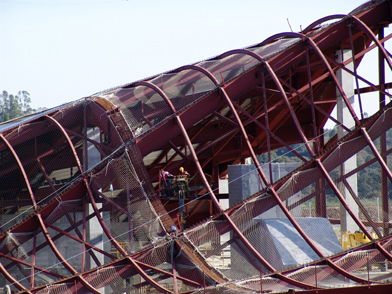
We had to request a special permission to enter the building site. It looks like a big volcano crater just after an eruption: The atmosphere is still and quiet while, it is clear that the monstrous devastation has just taken place. Too late! This is a site of disaster.
“The disaster ruins everything, all the while leaving everything intact. It does not touch anyone in particular; “I” am not threatened by it, but spared, left aside. It is in this way that I am threatened; it is in this way that the disaster threatens in me that which is exterior to me – another than I who passively become other. Out of reach is he whom it threatens whether from afar or closes up, it is impossible to say: the infiniteness of the threat has in some way broken every limit. We are on the edge of disaster without being able to situate it in the future…” (“The Writing of the Disaster” by Maurice Blanchot)
It is Peter Eisenman himself, the architect of the Cultural City of Galicia, who refers to disasters within his own writing. Did he ever think, outside of metaphors, that his own work may be creating and provoking disasters? “He frequently cites The Writing of the Disaster, one of the essential texts of Maurice Blanchot, and his architecture shows the same exigent fascination with denial, the same radical search for emptiness, the same deliberate vertigo towards nothingness; but also the same penchant for paradox, word games, and abstruse formalism.” (Codex, p. 17) These are conceptual turns but the architect would most likely never think of his own work being a disaster or that it could create any kind of devastation. Or, on the other hand, might he even be proud that that might happen due to his work; that is, if he or his work were the cause of disaster? In the end, his architecture would create an immediate effect; the kind of effect that the city of Santiago de Compostela will have to live with for a long time.
I can’t say that the Cultural City of Galicia is a disaster because it has not been completed yet. Even so, it is very hard to believe (according to many parameters and conditions of the project) that it will be a success. What I question in this case is not the formal representation of its architecture on the hill of Monte Gaia, designed by Peter Eisenman, but rather the centralization of cultural institutions within a mega structure, in a countryside that has been characterized by typological fragmentation and small scale settlements for centuries.
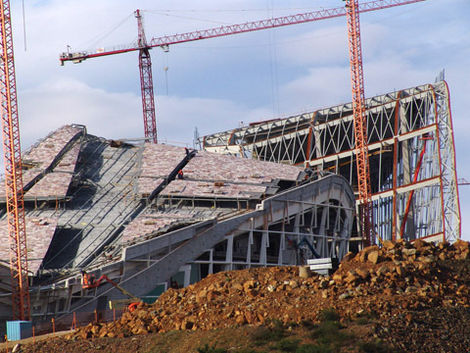
The countryside of Galicia, in the northwestern corner of Spain, is known for its numerous small villages and towns, which are spread out through the hills. This pattern must also represent, in many ways, the mentality of the people living in Galicia. In this case, however, it seems that no one has thought about the importance of the context of the existing everyday culture.
The whole project is convoluted with highly sophisticated language of symbolic connotations mainly referring to the most obvious historical fact of the place—the presence of Saint James. Santiago de Compostela is the home of the most important codices of the medieval era, the Codex Calixtinus, named after Pope Calixto II. It has five parts that mainly talk about Saint James. The last part, “guide for traveling pilgrims,” became the inspiration for Peter Eisenman for the creation of his extremely oversized project. I feel sorry for Saint James! He and his story are constantly abused. This highly spiritual entity is being represented by the most banal, strictly market-oriented materialization. It is clear to everyone today that the beautiful city of Santiago de Compostela became a well known tourist destination due to its rich and important history. Tourism based on culture became one of the leading economic drives for the entire region, not only in Galicia but around the world. This is a fact! The City of Culture is based on this idea: building cultural institutions will attract tourists, who will bring money, which will provide more work and improve the economy. The scenario is clear, and it used to work!
Unless … people in key positions including architects misunderstood the idea of scale in relation to context. As Michael Keating writes in his article “Rethinking the Region,” “The qualities of territories themselves are going beyond matters of location and infrastructure, into the social construction of the local economy. This has been heavily influenced by economic sociology (Swedburg 1993), by work on the ‘social construction of the market’, and by the debate on different models of capitalism. All of these have sought to demonstrate that there is not one best mode of production, that capitalism is socially embedded and takes different forms in different places, and that the market is, like other social phenomena, a human product which also takes different forms in different contexts. Territory then becomes, not merely location, but the basis of a whole complex of social relationships, behaviors and norms.” This cleary states that the “Bilbao effect” cannot be repeated by simply re-seizing and re-placing the existing model.
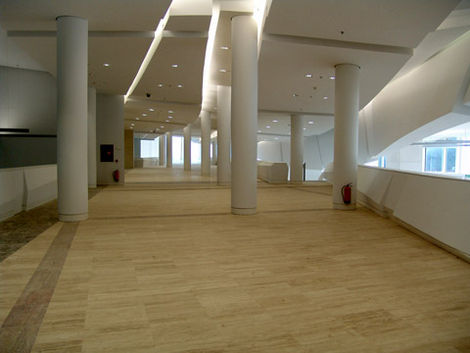
Sublime Reflection on Emptiness I
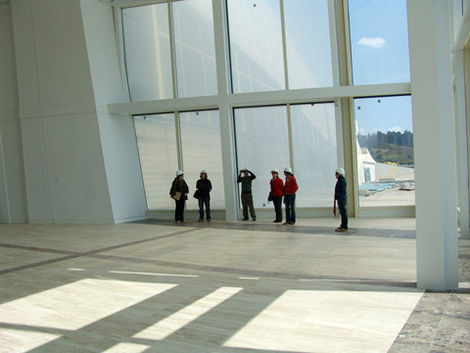
Sublime Reflection on Emptiness II
The misunderstanding of the context in the case of the Cultural City of Galicia is not only created by the American architect but also by the local politicians and other professionals in power at the time of the commission. Money, power, and the strive for immortality have been the main driving forces for this project. No one talks about how Galician people— the people who represent and create the culture of the place—those who are part of the culture itself—could be involved in this project. The people who are financing culture did not decide to build such a cultural mega structure; it is obvious that the decision was made on a higher political level; it was made by people who were eager to create just one more monument for themselves. In this case we are facing, once again, one of the many examples of failed democracy.
“But it is not the architect’s fault,” one might say, “He is just complying with the requirements of the client.” Should an architect just listen to the client and do what the client wants without any critical thought, without any moral or ethical responsibility, not even to himself? If there has been a moral codex in the architecture profession, now it has certainly replaced by the codex of business. This drives said profession into a very limited, non-critical field of operation. It becomes simply a service for whoever might need it—a king, a priest, or a thief—that fits with every possible ideology.
According to Giancarlo De Carlo, the conformist position has been the role of the architect throughout history. In different historical epochs depending on the use to which political power put him, the architect has been more of a head brick layer or more of a god. But in all epochs, whatever the importance of his role, the architect has been subject to the world view of those in power. Therefore, we should question the credibility of architecture even nowadays, even within a project like the Cultural City of Galicia, which pretends to represent higher goals.
“At the same time, the morphological and structural conceptions and the operative tools which until now governed architectural production are thrown into question. A vast set of variables which institutional culture and practice had suppressed come back into play, and the field of reality in which architecture intervenes becomes macroscopic and complex..” (Giancarlo De Carlo; Architecture’s public)
Therefore I had to ask myself some questions when I visited Monte Gaia to see the building site of the new Cultural City of Galicia:
Has the architect finally created a disaster? (No metaphors or symbolic analogies, please!) Who has put him into this dreadful, unpleasant situation? Did any of those glamorous participants of the architecture competition revisit the program in relation to the context? Why did no one protest?
Is there another God who will appreciate the richness of symbolic language built into the project of the City of Culture, and have mercy on its creators?
Amen.
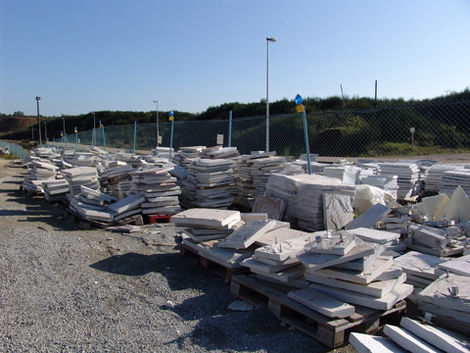
Left for tomorrow
References:
- CODEX The City of Culture of Galicia, edited by Cynthia Davidson ; The Monacelli Press Inc., New York, 2005
- The Writing of the Disaster, by Maurice Blanchot ….(place, editor, year)
- Rethinking the Region. Culture, Institutions and Economic Development in Catalonia and Galicia, written by Michael Keating, ECPR Workshop, Regionalism Revisited. Territorial Politics and the Age of Globalization, Mannheim, March 1999
- Architecture & Participation; edited by Peter Blundell Jones, Doina Petrescu, Jeremy Till; Spoon Press, New York, Abingdon, Oxon, 2005
- News Release, Tuesday 3 April, 2001, 21:00 GMT, distributed by PR Newswire on behalf of The Kreisberg Group




